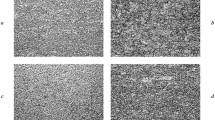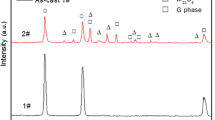Conclusions
-
1.
As compared with ordinary steel, the VI+EBR steel contains less oxygen, nitrogen, sulfur, tin, arsenic, antimony, and nonmetallic inclusions.The VAR steel contains fewer oxide and sulfide nonmetallic inclusions than ordinary steel.
-
2.
The cleaner steel has a greater tendency to grain growth, which increases with temperature.
-
3.
Under conditions of ductile fracture the fracture toughness of the VI+EBR steel is two to three times that of ordinary steel, although the ductile-to-brittle temperature (determined from the type of fracture) is the same as that of ordinary steel.The increase of the fracture toughness after remelting is due to the increase in the work of crack propagation. The work of crack initiation and the ductile-to-brittle temperature remain unchanged.
Similar content being viewed by others
Literature cited
A. P. Gulyaev, Zavod. Lab., No. 4 (1967).
Additional information
Central Scientific-Research Institute of Ferrous Metallurgy. Translated from Metallovedenie i Termicheskaya Obrabotka Metallov, No. 10, pp. 2–5, October, 1970.




